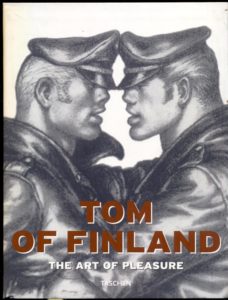Finals will be over soon, but for now they are still eating my brain and making me a highly-tuned ball of vibrating stress. I managed to get to see one movie this weekend, in spite of that.
Almost everyone who has sought out queer culture knows the work of Touko Laaksonen. Tom of Finland, as he is known in the U.S., was an artist with a strong, bold style who celebrated male bodies and male desire.
Even if you don’t know his name, you may well have seen his work – muscular men naked or ensheathed in tight leather or uniforms. Men on display. Men who flaunt it in a way that has been outright dangerous in most of modern history (and still is, plenty of places).

I encountered his work all over the place in the nineties. I remember visiting London back in the very early aughts, when a friend of mine was working there. I bought a little book of Laaksonen’s work that Taschen had published. This nod of understanding went between me and the clerk at the purchase (though all he said was ‘I love him!’, referring to Tom).
Some of the art is explicitly sexual, some merely erotic. None of it hides a thing.
Having experienced my own queer awakening when his work was already firmly part of the gay culture, I was very interested in seeing the biopic of him. Covering a huge swath of the mid twentieth-century, the film smoothly brings us from era to era, highlighting the challenges faced by gay men in each and the ways they worked around those challenges.
The challenges, though they loomed too large to be ignored, were not the focus of the film. The focus was an artist’s persistent love and drive and desperate desire to depict and see a world in which he could not only live freely, but be happy. The film depicts Laaksonen not as an idealist but as someone whose sexual identity is fundamental to his own health and well-being and who won’t pretend to be what he is not.
He will, in both his cynicism over the world’s inability to change and his perseverance in the face of the world being truly awful, be relateable to a broad swath of the queer community, I believe.
The film goes through some dark places but it has this core of thrumming delight. It takes us into Laaksonen’s desires and shows us what strength they give him. It runs the emotional gamut and takes us through war and brutality and repression but also through moments of freedom and light and clarity.
My comment on twitter when coming out of the film was “That might be the first time I’ve wept with joy and triumph at the notion of a room full of joyous leathermen being themselves, but I can’t be certain.”
It filled me with joy and pride and determination – a kind of patriotism for queerlandia, wishing to fight for her honor and sing her praises.
It’s been a pretty good couple of years for queer cinema. Between Moonlight‘s (well deserved) oscar wins, the Battle of the Sexes biopic, the wonderful and powerful James Baldwin documentary I Am Not Your Negro, a slate of acclaimed indies and even a few wide release action movies with queer leads, it’s been a joy and a relief to be a non-straight person in a movie theater seat several times.
Do I want more? Absofuckinglutely. This is my gay agenda: I won’t be happy till we have action movies with openly gay leads, lesbians in space, trans folks in political dramas and romcoms and bipan people who openly admit they’re bipan on screen. There’s so much further we can get, but damn, we’ve come a long way.
But I digress. Tom of Finland is well worth seeing – Pekka Strang’s acting as is excellent and the film pulls no punches, celebrates its opportunities for joy and brings you through a chunk of history with its subjects. You will laugh, you’ll cry, you’ll gasp in horror and you’ll be filled with inner joy.
It’s not perfect. No film is. And one of these days I’m going to write about the parts that women and folks of color play in films that focus on gay white cis men in detail, because it bothers me, but for now, let us pledge allegiance to the rainbow flag of the united states of Queerlandia…
